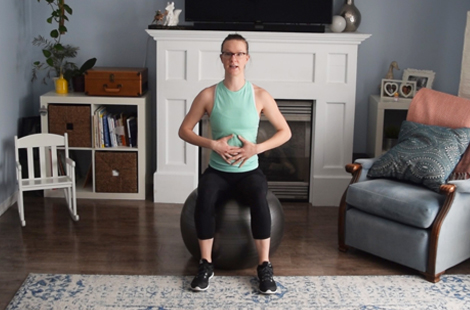6 Pelvic Exercises That Help Stop Post-Baby Pee Dribbles
(Original Article CBC – http://www.cbc.ca/parents/learning/view/6-workouts-that-help-stop-post-baby-pee-dribbles Jan 31 2017)
Scenario one: Urinary urge incontinence
You’re standing in line to buy your groceries and all of a sudden you get this uncontrollable urge to pee. Oh shoot — what can you do? You’re nowhere near the washroom and all the food is on the conveyer already. You hope and pray that you can control the urge until you get to the bathroom. Then — oh no — you let a little out! You’re a grown woman, not a toddler. You wonder, shouldn’t you be able to control this urge? Your friends say, “Thats normal, you had a baby!”
Scenario two: Urinary stress incontinence
You’re getting ready for an exercise class and you go to pee before the class — just in case. It’s a tough class, so you drink a lot of water. Halfway through, your instructor yells out, “Okay, now let’s do some squat jacks!” (It’s a jumping jack into a squat.) Oh no, you think. You start to do the exercise and yes, you guessed it — you leak a little pee!
Both these scenarios are very common in women who have given birth, and it doesn’t even have to be a vaginal delivery either, C-section mamas suffer too. The downward pressure during the 40+ weeks of pregnancy causes a weakening and/or tightening of the pelvic floor, teamed with poor alignment and improper breathing techniques. The core muscles start to shut down and malfunction (so to speak), which leads to urinary leakage. Now this is just a brief explanation on the subject, there are many more causes other than poor alignment and poor breathing techniques. My main aim here is to enlighten you and tell you that you DON’T have to suffer, it CAN be fixed (or symptoms reduced, depending on the severity of damage). You don’t have to leak when you cough, sneeze, squat or jump!
It wasn’t until well into motherhood that I realized I was having issues. I was so focused on being a good mother (and dealing with an injury) that I ignored the symptoms and brushed it off thinking it’s okay, it’s normal, lots of women are incontinent. IT ISN’T NORMAL! It’s common, but NOT normal. Hopefully I am reaching you early into your journey, but if I haven’t, that’s okay — it can be treated years later.
Step One: Physiotherapy
Book an appointment to see a pelvic floor physiotherapist. There are so many talented therapists in Canada that can help to figure out the WHY behind your incontinence. Google your province’s physiotherapist’s association to find someone near you. I recommend all women go visit a physio regardless of If they are incontinent, it can reveal a lot about your pelvic health and prevent any future occurrences.
Step Two: Belly Breathing
While you wait for your appointment (some physiotherapists have a long wait list), learn how to do a belly breathe, also known as diaphragmatic breathing.

Start sitting on a ball or lying on your side, take a few deep breaths into your belly whilst trying not to let your ribcage rise or fall. Inhale through your nose while your belly moves out, and exhale through your mouth (pursed lips) as your belly draws back in. Once you have mastered breathing into your belly, try incorporating your pelvic floor. On the inhale, feel your pelvic floor soften and drop down (do NOT push it down) and your belly move out. Then, on the exhale, imagine you are scooping something up off the floor, lifting your pelvic floor up off the ball and pulling your belly up and in. Focus on your breath every day and do 10 deep belly-breaths every morning and every night. This can be introduced as early as one week postpartum, as long as you feel comfortable and don’t feel any discomfort.
This is the foundation to everything — when exercising, you need to use this breath to move. When you are doing the hardest part of the exercise (usually the lift/pull/push), you need to exhale and lift the pelvic floor (e.g. inhale as you lower into a squat, exhale as to lift out of a squat).
Step Three: Exercises
Follow these exercises and focus on proper postural alignment throughout the day. Complete 10 repetitions of each exercise, three times round. Try to remember to do them every day. I tend to do them first thing before I get out of bed so I know they have been done for the day.
- Bent leg heel slide — x 10 per leg
- Side-lying bent leg lift — x 10 per side
- Side-lying clam — x 10 per side
- Butterfly — x 10 (Focus on fully relaxing at the bottom of the move and lift using your glutes — specifically gluteus medias, the outer glute muscle — rather than your hip flexors.)
- All-fours toe tap — x 10 per leg
Happy workouts, mamas! And don’t forget to consult with a medical professional before beginning any exercise regime.
Links to our services:
http://zenithphysiopilates.com/services/pelvic-health/
Other articles:


Pingback: